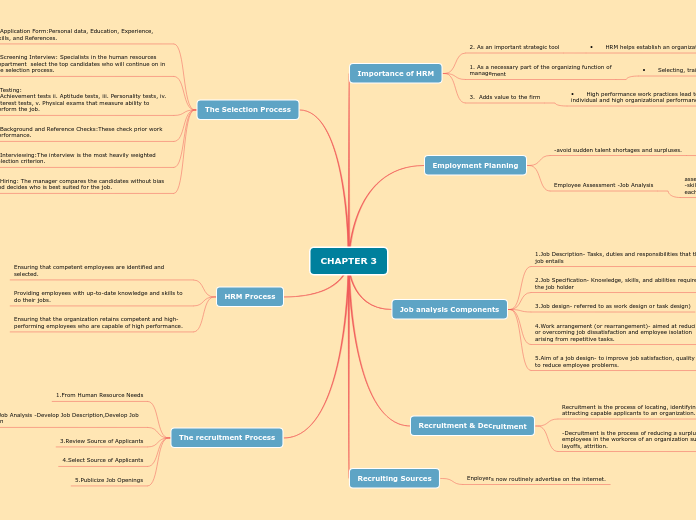CHAPTER 3
Importance of HRM
2. As an important strategic tool
• HRM helps establish an organization’s sustainable
1. As a necessary part of the organizing function of
management
• Selecting, training, and evaluating the work force
3. Adds value to the firm
• High performance work practices lead to both high
individual and high organizational performance.
Employment Planning
-avoid sudden talent shortages and surpluses.
Steps in the planning process:
1. Assessing current human resources
2. Assessing future needs for human resources
3. Developing a program to meet those future needs
Employee Assessment -Job Analysis
assessment of the kinds of:
-skills, knowledge, and abilities needed to successfully perform each job in an organization.
Job analysis Components
1.Job Description- Tasks, duties and responsibilities that the job entails
2.Job Specification- Knowledge, skills, and abilities required of the job holder
3.Job design- referred to as work design or task design)
4.Work arrangement (or rearrangement)- aimed at reducing or overcoming job dissatisfaction and employee isolation arising from repetitive tasks.
5.Aim of a job design- to improve job satisfaction, quality and to reduce employee problems.
Recruitment & Decruitment
Recruitment is the process of locating, identifying and attracting capable applicants to an organization.
-Decruitment is the process of reducing a surplus of employees in the workorce of an organization such as firing, layoffs, attrition.
Recruiting Sources
Enployers now routinely advertise on the internet.
The Selection Process
1.Application Form:Personal data, Education, Experience, Skills, and References.
2.Screening Interview: Specialists in the human resources department select the top candidates who will continue on in the selection process.
3.Testing:
i. Achievement tests ii. Aptitude tests, iii. Personality tests, iv. Interest tests, v. Physical exams that measure ability to perform the job.
4.Background and Reference Checks:These check prior work performance.
5.Interviewing:The interview is the most heavily weighted selection criterion.
6.Hiring: The manager compares the candidates without bias and decides who is best suited for the job.
HRM Process
Ensuring that competent employees are identified and selected.
Providing employees with up-to-date knowledge and skills to do their jobs.
Ensuring that the organization retains competent and high-performing employees who are capable of high performance.
The recruitment Process
1.From Human Resource Needs
2.Conduct Job Analysis -Develop Job Description,Develop Job Specification
3.Review Source of Applicants
4.Select Source of Applicants
5.Publicize Job Openings
